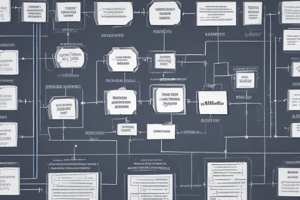Podcast
Questions and Answers
What is the purpose of using extension points in use cases?
What is the purpose of using extension points in use cases?
- To prevent the use case from being extended
- To exclude certain behaviors from a use case
- To limit the behavior of a use case
- To model optional parts of a use case (correct)
In the context of use cases, what does generalization refer to?
In the context of use cases, what does generalization refer to?
- Identifying use cases that accomplish the same goal in different ways (correct)
- Identifying use cases that accomplish different goals
- Having many variations within a single use case
- Creating multiple unrelated use cases
How can extension points enhance the flexibility of a use case?
How can extension points enhance the flexibility of a use case?
- By removing certain behaviors from the use case
- By allowing the use case to be extended under specific circumstances (correct)
- By restricting the behavior of the use case
- By creating separate use cases for each behavior
Which statement best describes the role of extension points in use case modeling?
Which statement best describes the role of extension points in use case modeling?
What is the main purpose of generalization in use case modeling?
What is the main purpose of generalization in use case modeling?
What is the purpose of 'extends' in a use-case scenario?
What is the purpose of 'extends' in a use-case scenario?
How can 'includes' be understood in the context of use-case scenarios?
How can 'includes' be understood in the context of use-case scenarios?
In a use-case scenario, what is the primary purpose of capturing exceptional cases in separate use-cases?
In a use-case scenario, what is the primary purpose of capturing exceptional cases in separate use-cases?
When using use cases, what is the key benefit of identifying the actors who will be using the system?
When using use cases, what is the key benefit of identifying the actors who will be using the system?
What is the difference between 'includes' and 'extends' in a use-case scenario?
What is the difference between 'includes' and 'extends' in a use-case scenario?
What is the purpose of Forward engineering?
What is the purpose of Forward engineering?
Which term describes the process of reconstructing a model from the implementation?
Which term describes the process of reconstructing a model from the implementation?
What is the purpose of a package in structural modeling?
What is the purpose of a package in structural modeling?
Which UML diagram captures user-visible functions that achieve discrete goals?
Which UML diagram captures user-visible functions that achieve discrete goals?
What is the main purpose of an extension point in UML?
What is the main purpose of an extension point in UML?
Which term describes the process of going both ways between a model and implementation?
Which term describes the process of going both ways between a model and implementation?
Flashcards are hidden until you start studying
Study Notes
Use Case Modeling
- Use cases can have variations, and instead of drawing all possible variations as separate use cases, we can have further use cases that extend the basic behavior.
- The association allows a basic use case to incorporate additional behavior under certain circumstances.
Extend and Include Relationships
- Extends allows specifying a conditional include.
- Includes are used when you have a piece of behavior that is similar across many use cases.
- Examples of includes: valuation, validate user interaction, sanity check on sensor inputs, and check for proper authorization.
Use Case Generalization
- Use case generalization identifies use cases that accomplish the same goal but in different ways.
- We can note the similarity by using generalization.
Identifying Use Cases
- Identify the actors: who will be using the system?
- Identify the goals: what do they want the system to do for them?
- Identify key scenarios: what outcomes or workflows need to be considered?
UML Diagrams
- Use case diagrams show the relationships between actors and use cases.
- Class diagrams show the structure of the system.
Structural Modeling
- Subsystems are packages or holders for grouping elements.
- Use case modeling captures some user-visible function.
- A use case achieves a discrete goal for the user.
Capturing Use Cases
- Use cases can be captured or elicited by understanding the user's goals and scenarios.
- Examples of use cases: format a document, request an elevator, etc.
Studying That Suits You
Use AI to generate personalized quizzes and flashcards to suit your learning preferences.




